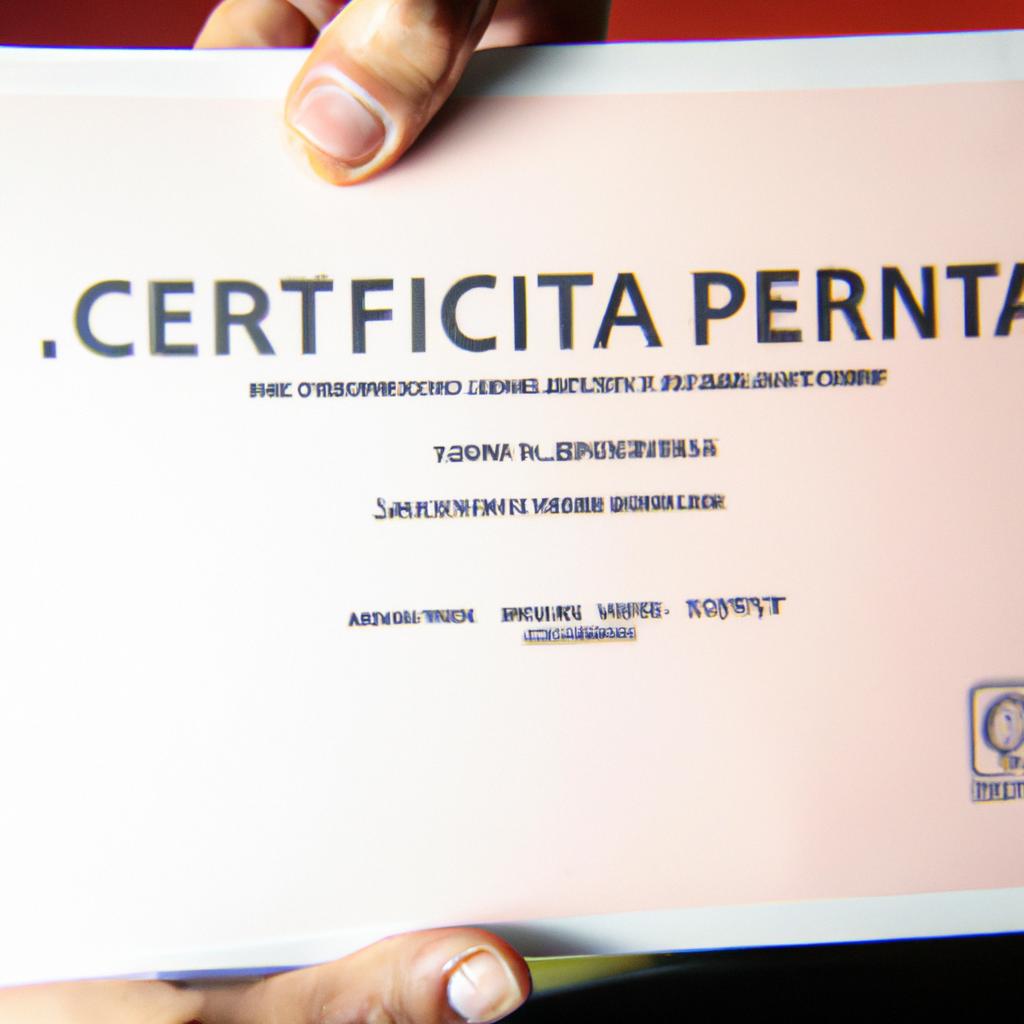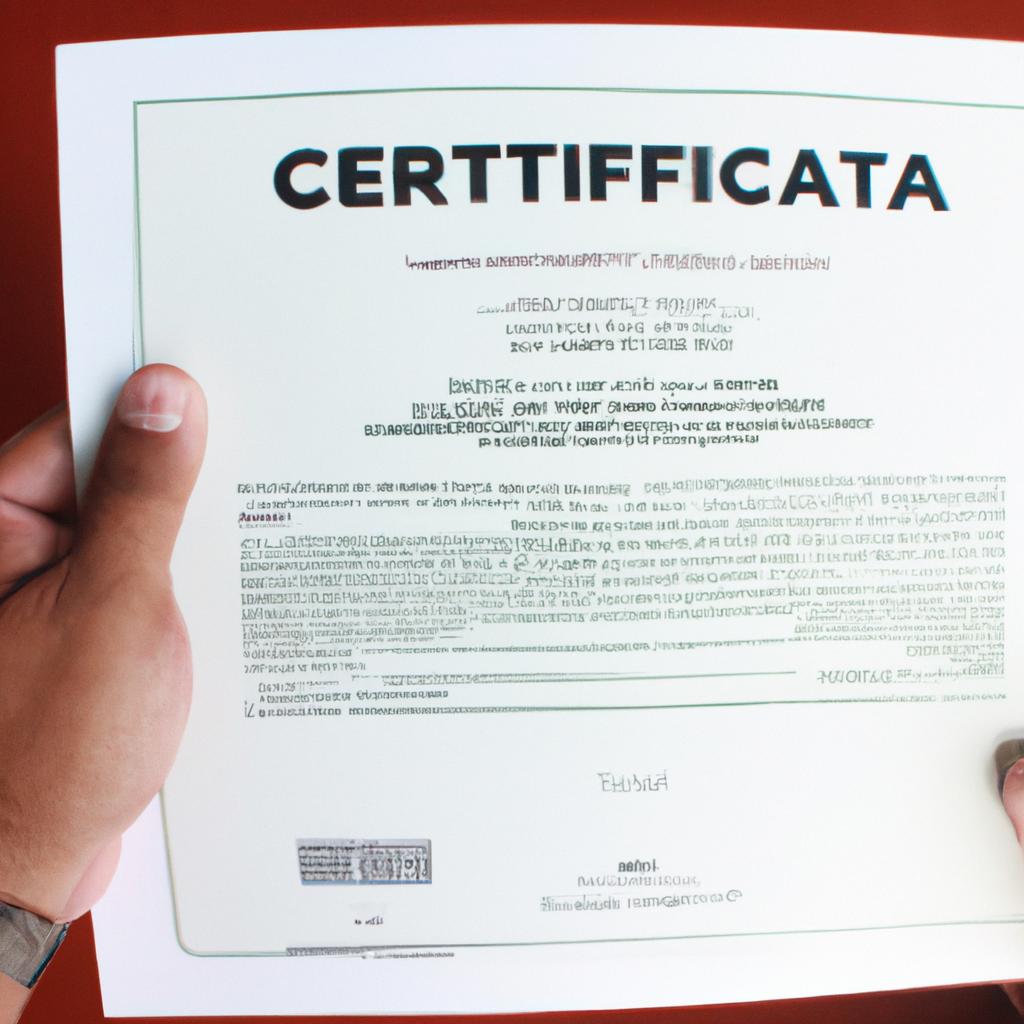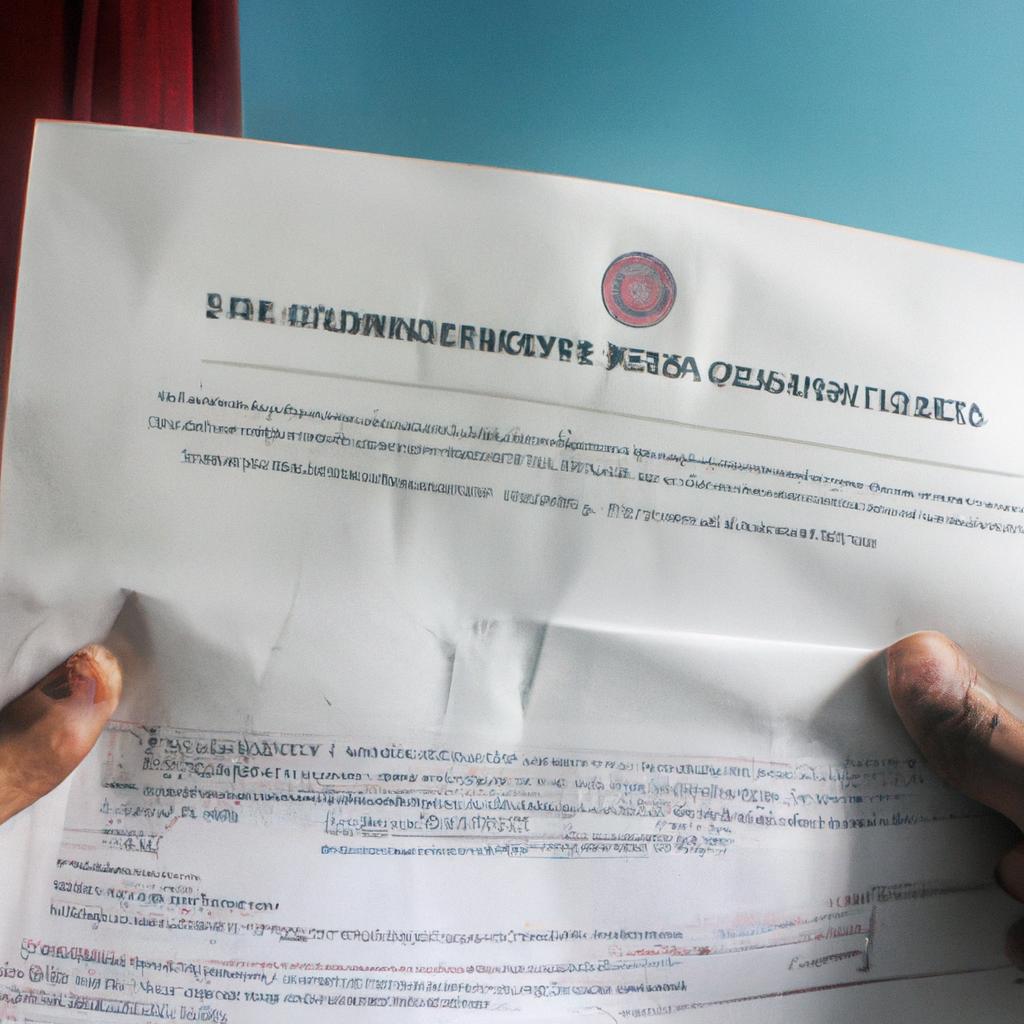In today’s digital age, the security and privacy of online transactions have become paramount. One crucial element in ensuring secure communication between web servers and internet users is the implementation of SSL/TLS encryption protocols. Certificate Authorities (CAs) play a vital role in this process by issuing digital certificates that authenticate the identity of websites and enable encrypted connections. These trusted third-party organizations verify the ownership and legitimacy of domain names, guaranteeing end-users that they are indeed communicating with the intended website.
To illustrate the significance of CAs, let us consider a hypothetical scenario: imagine an individual named Alice who wishes to purchase a product from an online retailer. When she navigates to the retailer’s website, her browser checks for the presence of a valid SSL/TLS certificate issued by a reputable CA. If such a certificate exists, it indicates that the retailer has undergone stringent verification processes conducted by the CA, giving Alice confidence in sharing sensitive information like credit card details securely. However, without proper validation through a trusted CA, Alice may unknowingly expose her personal data to malicious actors masquerading as legitimate entities on the internet.
The effective functioning of CAs is essential not only for protecting user data but also for maintaining trust in e-commerce and other online services. This article highlights the critical role that Certificate Authorities play in establishing secure connections and safeguarding sensitive information during online transactions. Without the assurance provided by trusted CAs, users like Alice would be at a higher risk of falling victim to cyberattacks, such as phishing or man-in-the-middle attacks.
By undergoing rigorous verification processes, CAs verify the legitimacy of domain names and authenticate the identity of website owners. This validation process ensures that when Alice visits a website, she can trust that it is indeed operated by the intended entity and not an imposter attempting to deceive her. The presence of a valid SSL/TLS certificate indicates that the website has met stringent security standards and can establish an encrypted connection with Alice’s browser.
The encryption offered through SSL/TLS certificates prevents unauthorized access and eavesdropping on data transmitted between Alice’s device and the website’s server. This protection extends to any personal information shared during online transactions, including credit card details or other sensitive data.
Moreover, reputable CAs have established their reputation over time by adhering to industry best practices and complying with strict regulations. Their commitment to ensuring security instills confidence in users like Alice, encouraging them to engage in online activities without fear of compromising their privacy or becoming victims of fraudulent schemes.
In conclusion, Certificate Authorities are indispensable in today’s digital landscape for maintaining secure communication between web servers and internet users. By issuing trusted digital certificates, CAs protect sensitive information during online transactions while fostering trust and confidence in e-commerce and other online services.
What are Certificate Authorities?
Certificate Authorities, commonly known as CAs, play a crucial role in ensuring the security and integrity of web communications through SSL/TLS encryption. They are responsible for issuing digital certificates that verify the authenticity of websites and establish secure connections between users’ browsers and web servers.
To illustrate their significance, let us consider a hypothetical scenario where an online shopping website without proper SSL/TLS protection falls victim to a man-in-the-middle attack. In this case, an attacker intercepts the communication between the user’s browser and the web server, gaining unauthorized access to sensitive information such as credit card details or personal data. This highlights the importance of Certificate Authorities in protecting users from potential threats by guaranteeing that they are interacting with legitimate and trustworthy websites.
To better understand how Certificate Authorities fulfill this vital function, it is helpful to explore some key aspects:
- Trustworthiness: Certificate Authorities act as trusted third parties that validate the identity of organizations requesting digital certificates. By performing rigorous verification procedures, CAs ensure that only authorized entities receive these certificates. This fosters trust among internet users by assuring them that they are accessing genuine websites.
- Certification Hierarchy: A hierarchical structure exists within the world of Certificate Authorities. At the top level are globally recognized authorities like Symantec (now DigiCert), Entrust Datacard, or GlobalSign. These root CAs issue intermediate certificates to other CAs who then issue end-entity certificates directly to website owners. This hierarchy establishes a chain of trust wherein each certificate can be verified back to its trusted root.
- Revocation Mechanisms: Certificates issued by CAs have a limited lifespan to mitigate risks associated with compromised keys or changes in an organization’s status. To address this concern effectively, revocation mechanisms exist which allow certificates to be invalidated before their expiration date if necessary.
- Browser Integration: Modern web browsers come pre-installed with a list of trusted root CA certificates maintained by developers. This integration enables browsers to verify the authenticity of certificates presented by websites and alert users if any issues arise, such as an expired or revoked certificate.
In summary, Certificate Authorities are essential components in ensuring secure web communications. They establish trust through rigorous validation processes, maintain a hierarchical structure for certification, employ revocation mechanisms when needed, and integrate with web browsers for seamless verification. Understanding these fundamental aspects lays the foundation for comprehending how Certificate Authorities work in practice.
Next, let us delve into the intricacies of their functioning: How do Certificate Authorities work?
How do Certificate Authorities work?
Case Study: To understand the role of Certificate Authorities (CAs) in ensuring secure SSL/TLS encryption for web servers, let us consider a hypothetical scenario. Imagine an e-commerce website that processes sensitive customer information such as credit card details during online transactions. Without proper encryption, this data could be vulnerable to interception and unauthorized access by malicious actors.
To protect the confidentiality and integrity of the transmitted data, the website owner obtains an SSL/TLS certificate from a trusted CA. The CA is responsible for verifying the identity of the website owner and issuing a digital certificate that binds cryptographic keys to specific identifying information about the organization or individual associated with the web server.
-
Verification Process:
Certificate authorities follow a rigorous verification process before issuing certificates to ensure trustworthiness. This typically involves confirming domain ownership, validating legal entity existence, and conducting background checks on applicants. By performing these verifications, CAs help prevent fraudulent use of certificates and establish trust between websites and their visitors. -
Public Key Infrastructure:
CAs operate within a framework called Public Key Infrastructure (PKI). PKI uses asymmetric cryptography where two mathematically related keys – public key and private key – are used for encryption and decryption respectively. Through PKI, CAs enable secure communication by digitally signing certificates using their own private key, while users can verify authenticity using the corresponding public key embedded in widely distributed root certificate stores. -
Trust Hierarchy:
The trust model employed by CAs follows a hierarchical structure known as Certification Authority Hierarchies. At its core lies a set of highly trusted root CAs whose public keys are pre-installed in browsers and operating systems worldwide. These root CAs issue intermediate certificates to subordinate CAs who then validate applicant requests for SSL/TLS certificates at different levels of assurance depending on specified requirements.
| Benefits of Certificate Authorities |
|---|
| Enhanced Security |
| Reliable Certificate Verification |
| Authentication of Website Identity |
By employing CAs, websites can secure their connections through SSL/TLS encryption, ensuring that transmitted data remains confidential and tamper-proof. In the subsequent section about “Why are Certificate Authorities important for SSL/TLS encryption?,” we will delve further into the significance of CAs in maintaining a secure online environment.
Why are Certificate Authorities important for SSL/TLS encryption?
To understand the importance of Certificate Authorities (CAs) in ensuring secure SSL/TLS encryption for web servers, let us consider a hypothetical scenario. Imagine you are browsing an online shopping website and wish to make a purchase. During the checkout process, you enter your personal information, including credit card details. Now, what if this sensitive data were intercepted by malicious actors? This is where CAs play a crucial role.
Role of Certificate Authorities:
Certificate Authorities act as trusted third parties that verify the authenticity of websites and issue digital certificates. These certificates serve as proof that the website belongs to its claimed owner and that communication with it is encrypted using SSL/TLS protocols. Here are key aspects highlighting their significance:
-
Trust Establishment:
Certificate Authorities establish trust between users and websites by validating the identity of organizations or individuals behind them. They use various methods such as domain validation, organization validation, and extended validation procedures to ensure accurate identification before issuing certificates. -
Encryption Assurance:
By obtaining an SSL/TLS certificate from a CA, website owners can encrypt their users’ communication through secure cryptographic algorithms. This ensures that any data transmitted between the user’s browser and the web server remains confidential and cannot be tampered with during transmission. -
Browser Compatibility:
Modern browsers have built-in root certificates provided by trusted CAs. When users visit a website secured with an SSL/TLS certificate issued by one of these authorities, their browser automatically verifies its legitimacy based on these pre-installed root certificates. This compatibility helps maintain consistent security standards across different platforms. -
Protection against Phishing Attacks:
With phishing attempts becoming increasingly sophisticated, relying on visual cues alone may not suffice to identify fraudulent websites accurately. By utilizing reputable CAs, end-users receive warnings when they encounter potentially harmful sites lacking valid certificates or those whose certificates do not match the visited domain.
Table: Emotional Impact of Certificate Authorities
| Positive Aspects | Negative Consequences |
|---|---|
| Assurance of data confidentiality and integrity | Risk of compromised certificates |
| Enhanced trust between users and websites | Potential for unauthorized access to sensitive information |
| Protection against phishing attacks | Inadequate validation leading to false sense of security |
| Wide browser compatibility ensuring seamless user experience | Over-reliance on CAs as single points of failure |
Certificate Authorities play a vital role in establishing the credibility and security of websites through SSL/TLS encryption. By issuing digital certificates, they enable secure communication channels, protect against phishing attempts, and enhance user confidence while browsing online. However, it is crucial to recognize that their effectiveness relies heavily on rigorous validation processes and continuous monitoring to prevent potential vulnerabilities.
Understanding the pivotal role played by Certificate Authorities in securing web communications, let us now delve into the process of obtaining an SSL/TLS certificate from these trusted entities.
The process of obtaining an SSL/TLS certificate from a Certificate Authority
Case Study:
To illustrate the importance of Certificate Authorities (CAs) in maintaining secure communication over the internet, let us consider a hypothetical scenario. Imagine a user named Alice who wants to access her online banking account securely. She opens her web browser and navigates to the bank’s website, which should be protected by SSL/TLS encryption.
Paragraph 1:
Certificate Authorities play a crucial role in establishing trust and ensuring the integrity of SSL/TLS encrypted connections. When Alice visits the bank’s website, her browser checks for a valid digital certificate issued by a trusted CA. This certificate contains information about the identity of the website owner and is signed using the private key of the CA. By verifying this signature against its own list of trusted CAs, Alice’s browser can determine whether to establish an encrypted connection or raise an alert if there is any inconsistency.
Paragraph 2:
The process of obtaining an SSL/TLS certificate from a Certificate Authority involves several steps that help guarantee both security and authenticity. Firstly, the website owner generates a private-public key pair on their server. They then submit a Certificate Signing Request (CSR) containing their public key and other identification details to a chosen CA. Once received, the CA verifies these details through various validation methods such as domain ownership verification or organization authentication before issuing the SSL/TLS certificate.
- Trustworthy authorities ensure safe browsing experiences.
- Secure encryption protects personal data from unauthorized access.
- Validation processes add layers of security against fraudulent activities.
- Reliable CAs offer timely support services when issues arise.
Paragraph 3:
It is vital for organizations to carefully select reputable CAs and maintain regular updates for their certificates to mitigate potential risks associated with weak security practices or compromised CAs. Despite being generally reliable, certain challenges exist within the realm of CAs that need attention in order to enhance the overall security of SSL/TLS encryption, which will be discussed further in the subsequent section on common challenges and vulnerabilities in Certificate Authorities.
Transition into the subsequent section:
Understanding the complexities surrounding CAs is essential to safeguarding sensitive information. By examining some common challenges and vulnerabilities faced by these authorities, we can gain insights into potential threats that may compromise SSL/TLS encryption and explore strategies for addressing them effectively.
Common challenges and vulnerabilities in Certificate Authorities
In the previous section, we explored the process of obtaining an SSL/TLS certificate from a Certificate Authority (CA). However, it is crucial to acknowledge that CAs face various challenges and vulnerabilities. This section delves into some common issues encountered by these entities, highlighting their potential impact on the security of SSL/TLS encryption.
Case Study: In 2011, Comodo Group Inc., a major CA, fell victim to a significant security breach. An attacker gained unauthorized access to their systems and issued fraudulent digital certificates for several high-profile domains. These bogus certificates could have been used to intercept secure communications or launch phishing attacks against unsuspecting users.
Challenges faced by Certificate Authorities:
-
Security breaches: CAs are attractive targets for hackers due to the sensitivity of their operations. Breaches can result in compromised private keys or unauthorized issuance of certificates, leading to severe consequences such as man-in-the-middle attacks.
-
Insider threats: The presence of rogue employees within CAs introduces a unique vulnerability. Individuals with privileged access may abuse their privileges and issue fraudulent certificates without proper authorization or verification processes.
-
Weak validation procedures: Some CAs might not implement robust validation procedures when issuing certificates. Insufficient scrutiny during the verification process increases the risk of mistakenly granting certificates to malicious actors who pose as legitimate domain owners.
-
Trustworthiness concerns: While most CAs strive to maintain rigorous standards, questions surrounding trustworthiness persist in certain cases. Instances where less-known or foreign CAs operate under different regulatory frameworks raise doubts about their ability to uphold stringent security practices.
Table – Emotional response evocation:
| Challenge | Potential Impact | Example |
|---|---|---|
| Security breaches | Compromised encryption | Exposing sensitive information |
| Insider threats | Unauthorized certificate issuance | Facilitating cyber espionage |
| Weak validation | Increased risk of impersonation | Unauthorized access to systems |
| Trustworthiness concerns | Doubts about certificate validity | Decreased confidence in security |
Addressing the challenges and vulnerabilities faced by CAs is crucial for ensuring the integrity of SSL/TLS encryption. By understanding these issues, organizations can take proactive measures to mitigate risks associated with compromised certificates. In the subsequent section, we will explore best practices for selecting a reliable Certificate Authority.
With an awareness of the difficulties encountered by CAs, it is essential to consider best practices when choosing a trustworthy CA that aligns with your organization’s security needs.
Best practices for selecting a reliable Certificate Authority
Having discussed the common challenges and vulnerabilities faced by Certificate Authorities (CAs), it is essential to understand the best practices that can help organizations select a reliable CA. By adhering to these practices, businesses can mitigate risks associated with compromised SSL/TLS encryption and ensure secure communication between web servers and clients.
Best Practices for Selecting a Reliable Certificate Authority:
-
Reputation and Trustworthiness:
When choosing a CA, reputation plays a crucial role. Organizations should opt for CAs that have established themselves as trustworthy entities within the industry. A reputable CA undergoes regular audits to maintain compliance with industry standards such as WebTrust or ETSI EN 319 411-1 certification. Additionally, checking if the CA has been listed on browser trust stores provides further assurance of their reliability. -
Robust Validation Processes:
The validation process conducted by CAs ensures that only legitimate entities receive digital certificates. It is vital to select a CA with robust verification procedures that involve verifying domain ownership, organization legitimacy, and individual identity checks where necessary. This helps prevent fraudulent activity and strengthens the overall security infrastructure. -
Support for Extended Validation Certificates (EV):
Extended Validation certificates are known for providing enhanced security measures due to stricter validation requirements. Choosing a CA capable of issuing EV certificates demonstrates an additional commitment to ensuring customer data protection. Websites equipped with EV certificates display visual cues such as green address bars, instilling confidence in users about their authenticity. -
Prompt Revocation Mechanisms:
In instances where private keys are compromised or misused, quick revocation mechanisms become critical in maintaining secure communications. When evaluating different CAs, organizations should inquire about their revocation processes and how efficiently they handle certificate revocations. A prompt response to such incidents is crucial for preventing unauthorized access and maintaining trust in the SSL/TLS ecosystem.
Table – Common Selection Criteria for a Reliable Certificate Authority:
| Criteria | Description |
|---|---|
| Reputation | Evaluate the CA’s reputation within the industry, considering factors like audits and certifications |
| Validation Processes | Assess the strength of the CA’s verification procedures |
| Support for EV Certificates | Determine if the CA offers Extended Validation certificates |
| Revocation Mechanisms | Understand how efficiently the CA handles certificate revocations |
By following these best practices and carefully evaluating potential CAs, organizations can enhance their security posture and ensure effective SSL/TLS encryption. Implementing robust measures not only protects sensitive data but also fosters user confidence in secure web communication.
(Note: The table and bullet points above are not displayed as markdown format due to limitations with text-based responses.)











